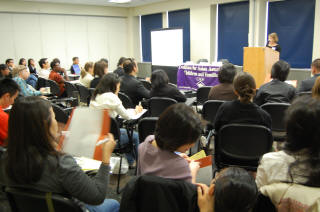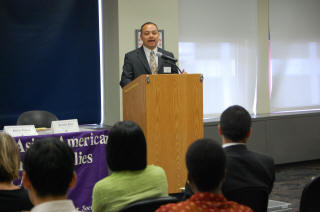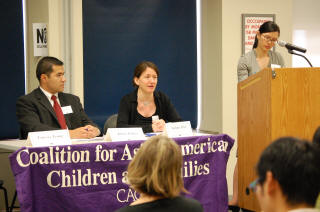Coalition for Asian American Children and Families
Presents

Time: 10AM to 12PM
Place: 25 West 43rd Street, 18th Floor
between 5th & 6th Avenues, Manhattan

A community briefing to release the Coalition for Asian American Children and Families’ newest report on the impacts of language brokering on families and to discuss the implications on policy and practice. Language brokering is the use of bilingual youths as translators and interpreters in daily situations without any special training. The increase use of language brokers in our community impacts health, education, and human service settings.

New York City’s Asian Pacific American community has doubled every decade for the last 30 years, becoming the most rapidly expanding group of the city and accounting for 11 percent of the city’s population. Of the approximately 873,000 Asian Pacific Americans in New York City, 78 percent are foreign-born, 28 percent speak little or no English, and 53% are born into poverty.
Recording Voices: Stories of Asian Pacific American Youth as Language Brokers in New York City provides a clearer picture of the impact of language brokering on the Asian Pacific American community.

Speakers
Kleber Palma
Director, Translation and Interpretation Unit
New York City Department of Education
Stefanie Trice
Senior Director, Office of LEP / Culturally and Linguistically Appropriate
Services (CLAS) NYC Health and Hospitals Corporation (HHC)

KEY FINDINGS: Recording Voices found that Asian Pacific American families often rely on children and youth to be translators and interpreters when accessing public services. While other research shows that there are positive impacts of being a language broker, youth identified negative impacts including the 1) increased burden when providing language assistance; 2) heightened anxiety, stress, and fear of miscommunication; 3) conflict with the family unit; and 4) role-reversal between parents and youth. Youth who were surveyed for the policy brief indicated that:
- 49% of youth translate for their parents “always/a lot.”
- 61% of foreign-born youth translate “always/a lot”, compared to 43% of native-born youth.
- 83% of youth translate notes and letters from school.
- 49% of youth translate forms from the doctor’s office.
RECOMMENDATIONS: Of all racial groups in New York City, Asian Pacific Americans have the highest rate of linguistic isolation (28%), meaning that no one over the age of 14 in a household speaks English well. To support Asian Pacific American language brokers and to promote equal access to essential services, CACF makes the following recommendations:
Resources: Increase funding for language assistance services in public settings to improve access for Asian Pacific American, immigrant, and linguistically diverse communities.
Monitoring: Implement a monitoring system to ensure that prompt and efficient language assistance services are being offered in all public health, education, and human service systems.
Community Education: Educate the Asian Pacific American community on their rights to language assistance services.
Training: Ensure that all individuals who have contact with Asian Pacific American families are knowledgeable about the availability of language assistance services and the procedures for accessing these services.
Collaboration: Build partnerships with Asian Pacific American led and serving community based organizations to promote language access.
Capacity Building: Increase capacity of Asian led and serving community based organizations to serve limited English proficient individuals.
ADDITIONAL INFORMATION: If you are interested in learning more about language brokers, you may want to see Childhood in Translation, a documentary project about how immigrant families are affected by language barriers and about how youth are often placed in the position of being linguistic and cultural brokers for their families. The project includes several short documentaries, and more information on the project and how to get the DVD is available at http://sojournfilmworks.com/projects/childhood/childhood.html and https://www.migrationpolicy.org/programs/language-access-translation-and-interpretation-policies-and-practices/language-portal-content.
Organizer: Coalition for Asian American Children and Families
Sponsored by
Asian American / Asian Research Institute, CUNY
